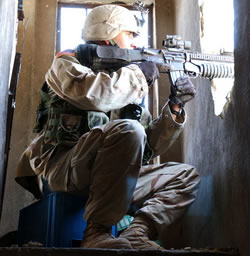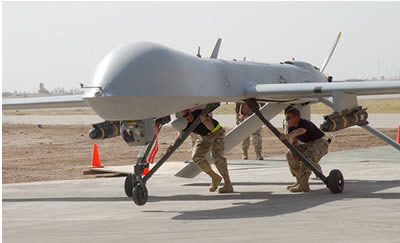Operations in urban terrain are characterized by “fluidity” of events, where opportunities to engage high priority targets occur unexpectedly and for only a few seconds, or at most, minutes. Rapid processing of information, on-the-spot decision making, and maintaining the ability to respond with split-second timing enables the military to take advantage of these transient opportunities. Coalition forces in Iraq and Afghanistan, and Israeli forces attempting to control the activities of the Palestinian fighters in Gaza and West Bank are already using such means.
Utilization of these capabilities requires the fielding of an extensive intelligence network, integrating all types of ISR operations including persistent sensors (operating continuously throughout the day, night, and adverse weather conditions), satellite imagery, aerial reconnaissance, elevated, stand-off aerial observation by long-range telescopes, and close-in views by mini UAVs, mast mounted or aerostat tethered imagers, radars and FLIRs, etc. Other feeds can be provided by covert, unattended ground sensors designed to monitor suspected enemy locations and report on enemy activity and movements before an operation. 
Other means used to collect information and build the total intelligence picture include signal intelligence, surveillance systems such as tracking radars, IR scanners and acoustic sensors, which can determine the location and concentration of suspicious activities.
Employment of snipers, linked via wireless into the intelligence sensor network, is an example of such close-loop kill chain. When a target of opportunity appears, and is positively verified by the intelligence team at the command level, the commander can order the sniper to take it out, rapidly “closing the loop” between sensor and shooter.
A different example of “accelerated kill-chain” involves the use of UAVs for “Hunter Killer” activities. These operations are becoming the basis for a new concept of “Air Domination” of urban areas. The operations are performed by armed UAVs that are equipped with sensors and weapons in order to perform surveillance and intervention missions simultaneously. UAVs are particularly suitable for this role because of their ability to cover large areas for extended durations.
UAVs also have the ability to accurately strike targets of opportunity, with localized lethal effect. Covering an area with observation and fire, UAVs such as the General Atomics Predatoror IAI/Northrop Grumman Hunter fly at an altitude of 10,000-16,000 feet, equipped with EO or SAR sensors and armed with Lockheed Martin Hellfire or Northrop/Grumman Viper Strike laser-guided weapons.
Sperwer B, a French derivative of the combat proven Sperwer UAV developed by Sagem, can be armed with two Israeli RAFAEL Spike LR electro-optically guided missiles. Other UAVs, such as the Elbit Systems Hermes 450 and IAI/MALAT Heron (both are in service with the Israeli Air Force) have already demonstrated the capability to carry significant external payloads, but no details have been released about the payloads that these vehicles will carry. Palestinian sources have repeatedly claimed that Israeli weaponized UAVs are frequently used against terrorists in the Gaza Strip.
Several systems currently under development in the USA, Europe and Israel, are pushing this concept to the limit, with the ability to simultaneously control many sensors and multiple UAVs over a large area, in support of multiple missions. When mature, these systems will be integrated into regional command centers to support overall intelligence gathering and activity and to facilitate rapid engagement of time critical targets. The ability to monitor multiple video streams gives command centers a total grasp of the battlefield situation as they examine it from every angle. Automated processes, such as automatic change detection, and movement indication assist in detection, and tracking of targets in real time. Other features, such as automatic target tracking have special significance for intelligence collection. Modern systems can turn observations into intelligence – for example, the Terrasight system is used by US forces for automatic tracking of a specific person through a crowded scene, plotting precise geolocation coordinates for each place the subject visits. Future capabilities will enhance this feature and enable specific ‘fingerprinting” of targets. Image surveillance data can be used in real time or stored for later analysis. Examining video records let intelligence teams review suspicious patterns of enemy movements. Integrated data allows them to locate and track centers of activity. And by watching for any increase in activity, analysts can estimate when an attack is imminent.
For urban combat operations, Human Intelligence (HUMINT) is still the most important intelligence gathering method. HUMINT does not necessarily involve use of specialized operators. Troops and patrols constantly operating in an area can provide excellent and highly focused HUMINT if properly trained and equipped. The ‘Every Soldier is a Sensor’ (ES2) program, currently in use by the US Army, is developing the skills and capabilities necessary to utilize regular soldiers for intelligence gathering activities.
Thanks to modern cellular communications, HUMINT does not always require direct contact between operators, agents, and the local population. Internet, wireless mobile phones, commercial phones, cameras, and SMS messaging have replaced the secret radio transmitters and Morse code of the past. These collaboration techniques enable HUMINT operators to recruit informers over the Internet, or via leaflets airdropped over an area of interest.
The Israelis in the Gaza area successfully employed these methods after the 2005 disengagement. Israeli intelligence organizations engaged in an integrated Information Warfare (IW) and PSYOPS campaign that provided Palestinians in Gaza with phone numbers where they could send information about suspected terrorist activities and locations of improvised rockets. The informers were not motivated by their love for Israel, or greed, but by the hope of removing the threat of Israeli retaliation from their homes. Over 1,500 calls were received during the first month. Many of the messages provided valuable, verifiable, real-time information proving that this innovative concept is viable in modern counter-insurgency warfare.
Additional parts of this article:
- The Challenges of Command and Control in Urban Operations
- The urban electromagnetic environment
- Information Warfare in urban Combat
- Effects Based Operations (EBO) in urban Combat
- Situational Assessment (SA) in urban Combat
- Backing the Vigilant Eyes ISR Networking for Urban Combat
- Accelerating the kill chain Closing the Sensor-to-shooter Cycle

















